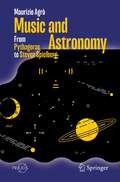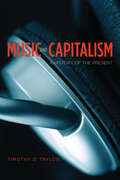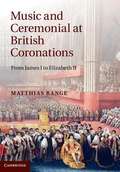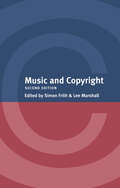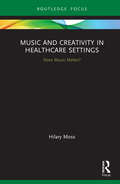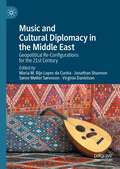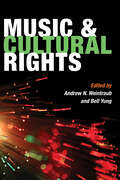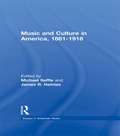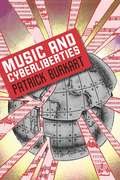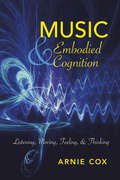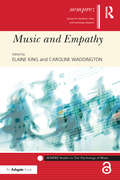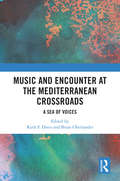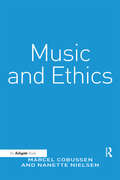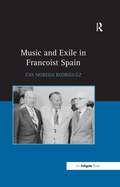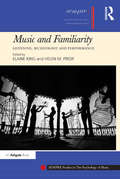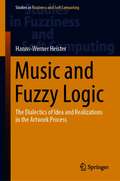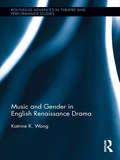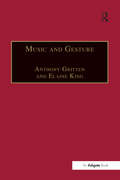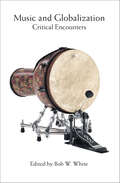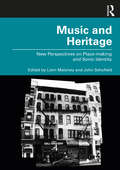- Table View
- List View
Music and Astronomy: From Pythagoras to Steven Spielberg (Springer Praxis Books)
by Maurizio AgròThis book explores the profound and ancient relationship between music and astronomy. Throughout history, Music has occupied a significant place among the disciplines of the Quadrivium, which also include Geometry, Arithmetic, and Astronomy. The captivating bond between these two realms has not only inspired eminent scientists like Kepler, Newton, and Einstein, but has also captured the imagination of NASA and astronauts in modern times. The author delves into various aspects of the intersection between music and astronomy, encompassing everything from ancient cosmological beliefs to groundbreaking discoveries such as the cosmic background radiation and gravitational waves. This enthralling theme has not only stimulated renowned artists like David Bowie and Elton John, but has also served as a muse for movies like Close Encounters of the Third Kind. Within the book, readers will find an extensive photo gallery and a specially curated soundtrack that enhances the reading experience. It caters to a broad audience, appealing to those with a general interest in both music and astronomy, as well as to specialized individuals in either field of study.
Music and Bad Manners
by Carl Van Vechten“SINGERS, musicians of all kinds, are notoriously bad mannered. The storms of the Titan, Beethoven, the petty malevolences of Richard Wagner, the weak sulkiness of Chopin (“Chopin in displeasure was appalling,” writes George Sand, “and as with me he always controlled himself it was as if he might die of suffocation”) have all been recalled in their proper places in biographies and in fiction; but no attempt has been made heretofore, so far as I am aware, to lump similar anecdotes together under the somewhat castigating title I have chosen to head this article.”-IntroductionCarl Van Vechten (B.A., University of Chicago, 1903) was a photographer, music-dance critic, novelist, and patron of the Harlem Renaissance who served as literary executor for Gertrude Stein.Van Vechten was among the most influential literary figures of the 1910s and 1920s. He began his career in journalism as a reporter, then in 1906 joined The New York Times as assistant music critic and later worked as its Paris correspondent. His early reviews are collected in Interpreters and Interpretations (1917 and 1920) and Excavations: A Book of Advocacies (1926). His first novel, Peter Whiffle (1922), a first-person account of the salon and bohemian culture of New York and Paris and clearly drawn from Van Vechten's own experiences, and was immensely popular.In the 1930s, Van Vechten turned from fiction to photography. His photographs are in collections at the Museum of Modern Art in New York and elsewhere. An important literary patron, he established the James Weldon Johnson Collection of Negro Arts and Letters at Yale.
Music and Capitalism: A History of the Present (Big Issues In Music Ser.)
by Timothy D. TayloriTunes. Spotify. Pandora. With these brief words one can map the landscape of music today, but these aren't musicians, songs, or anything else actually musical--they are products and brands. In this book, Timothy D. Taylor explores just how pervasively capitalism has shaped music over the last few decades. Examining changes in the production, distribution, and consumption of music, he offers an incisive critique of the music industry's shift in focus from creativity to profits, as well as stories of those who are laboring to find and make musical meaning in the shadows of the mainstream cultural industries. Taylor explores everything from the branding of musicians to the globalization of music to the emergence of digital technologies in music production and consumption. Drawing on interviews with industry insiders, musicians, and indie label workers, he traces both the constricting forces of bottom-line economics and the revolutionary emergence of the affordable home studio, the global internet, and the mp3 that have shaped music in different ways. A sophisticated analysis of how music is made, repurposed, advertised, sold, pirated, and consumed, Music and Capitalism is a must read for anyone who cares about what they are listening to, how, and why.
Music and Ceremonial at British Coronations
by Matthias RangeCoronations are the grandest of all state occasions. This is the first comprehensive in-depth study of the music that was performed at British coronations from 1603 to the present, encompassing the sixteen coronations that have taken place in Westminster Abbey and the last two Scottish coronations. Range describes how music played a crucial role at the coronations and how the practical requirements of the ceremonial proceedings affected its structure and performance. The programme of music at each coronation is reconstructed, accompanied by a wealth of transcriptions of newly discovered primary source material, revealing findings that lead to fresh conclusions about performance practices. The coronation ceremonies are placed in their historical context, including the political background and the concept of invented traditions. The study is an invaluable resource not only for musicologists and historians, but also for performers, providing a fascinating insight into the greatest of all Royal events.
Music and Conflict
by John Morgan O'Connell Salwa El-Shawan Castelo-BrancoThis volume charts a new frontier of applied ethnomusicology by highlighting the role of music in both inciting and resolving a spectrum of social and political conflicts in the contemporary world. Examining the materials and practices of music-making, contributors detail how music and performance are deployed to critique power structures and to nurture cultural awareness among communities in conflict. The essays here range from musicological studies to ethnographic analyses to accounts of practical interventions that could serve as models for conflict resolution. Music and Conflict reveals how musical texts are manipulated by opposing groups to promote conflict and how music can be utilized to advance conflict resolution. Speaking to the cultural implications of globalization and pointing out how music can promote a shared musical heritage across borders, the essays discuss the music of Albania, Azerbaijan, Brazil, Egypt, Germany, Indonesia, Iran, Ireland, North and South Korea, Uganda, the United States, and the former Yugoslavia. The volume also includes dozens of illustrations, including photos, maps, and musical scores. Contributors are Samuel Araujo, William Beeman, Stephen Blum, Salwa El-Shawan Castelo-Branco, David Cooper, Keith Howard, Inna Naroditskaya, John Morgan O'Connell, Svanibor Pettan, Anne K. Rasmussen, Adelaida Reyes, Anthony Seeger, Jane C. Sugarman, and Britta Sweers.
Music and Copyright: Romanticism And Copyright In The Music Industry (Law And Society Ser.)
by Simon Frith Lee Marshall"First Published in 2004, Routledge is an imprint of Taylor & Francis, an informa company."
Music and Creativity in Healthcare Settings: Does Music Matter?
by Hilary MossThrough a series of vivid case studies, Music and Creativity in Healthcare Settings: Does Music Matter? documents the ways in which music brings humanity to sterile healthcare spaces, and its significance for people dealing with major illness. It also considers the notion of the arts as a vessel to explore humanitarian questions surrounding serious illness, namely what it is to be human. Overarching themes include: taking control; security and safety; listening; the normalization of the environment; being an individual; expressing emotion; transcendence and hope and expressing the inexpressible. With an emphasis on service user narratives, chapters are enriched with examples of good practice using music in healthcare. Furthermore, a focus on aesthetic deprivation contributes to debates on the intrinsic and instrumental value of music and the arts in modern society. This concise study will be a valuable source of inspiration for care givers and service users in the health sector; it will also appeal to scholars and researchers in the areas of Music medicine and music Therapy, and the Medical Humanities.
Music and Cultural Diplomacy in the Middle East: Geopolitical Re-Configurations for the 21st Century
by Virginia Danielson Maria M. Rijo Lopes da Cunha Jonathan Shannon Søren Møller SørensenThis edited volume offers innovative perspectives on the study of music as cultural diplomacy in the Middle East and North Africa (MENA), a region often overlooked in such discussions. It offers an innovative contribution to the field of ethnomusicology, as well as political science and international relations, by highlighting the agency of non-state actors (local voices, communities, and grassroots organizations), thereby contributing towards de-centering the state, hitherto conceived as the chief player in cultural diplomacy.This volume is divided into four main parts organized along the following themes: 1. History and Historiography, 2. Migration, Diaspora, and Ethics, 3. Statecraft and Music Making, and 4. Affective and Sensorial Diplomacy. The perspectives offered in this volume offer a deeper exploration of bottom-up initiatives of cultural diplomacy through music, instead of the more usual analyses of top-down, state-directed programmes. Overall, the aim is to reconceptualize Middle Eastern, North African and Arab Gulf musical practices in their relationship to power and cultural diplomacy in order build a broader and pluri-dimensional account of these contentious relationships.
Music and Cultural Rights
by Helen Rees Andrew N. Weintraub Adriana Helbig Nimrod Baranovitch Javier F León Ana María Ochoa Silvia Ramos Felicia Sandler Amy Ku'Uleialoha Stillman Ricardo D Trimillos Bell YungFraming timely and pressing questions concerning music and cultural rights, this collection illustrates the ways in which music--as a cultural practice, a commercial product, and an aesthetic form--has become enmeshed in debates about human rights, international law, and struggles for social justice. The essays in this volume examine how interpretations of cultural rights vary across societies; how definitions of rights have evolved; and how rights have been invoked in relation to social struggles over cultural access, use, representation, and ownership. The individual case studies, many of them based on ethnographic field research, demonstrate how musical aspects of cultural rights play out in specific cultural contexts, including the Philippines, China, Hawaii, Peru, Ukraine, and Brazil. Contributors are Nimrod Baranovitch, Adriana Helbig, Javier F. Leon, Ana María Ochoa, Silvia Ramos, Helen Rees, Felicia Sandler, Amy Ku'uleialoha Stillman, Ricardo D. Trimillos, Andrew N. Weintraub, and Bell Yung.
Music and Culture in America, 1861-1918 (Essays in American Music #Vol. 2)
by Michael SaffleFirst Published in 1998. Routledge is an imprint of Taylor & Francis, an informa company.
Music and Culture in the Middle Ages and Beyond
by David J. Benjamin Brand RothenbergIt has become widely accepted among musicologists that medieval music is most profitably studied from interdisciplinary perspectives that situate it within broad cultural contexts. The origins of this consensus lie in a decisive reorientation of the field that began approximately four decades ago. For much of the twentieth century, research on medieval music had focused on the discovery and evaluation of musical and theoretical sources. The 1970s and 1980s, by contrast, witnessed calls for broader methodologies and more fully contextual approaches that in turn anticipated the emergence of the so-called 'New Musicology'. The fifteen essays in the present collection explore three interrelated areas of inquiry that proved particularly significant: the liturgy, sources (musical and archival), and musical symbolism. In so doing, these essays not only acknowledge past achievements but also illustrate how this broad, interdisciplinary approach remains a source for scholarly innovation.
Music and Cyberliberties (Music Culture)
by Patrick BurkartMusicians and music fans are at the forefront of cyberliberties activism, a movement that has tried to correct the imbalances that imperil the communal and ritualistic sharing and distribution of music. In Music and Cyberliberties, Patrick Burkart tracks the migration of music advocacy and anti-major label activism since the court defeat of Napster and the ascendancy of the so-called Celestial Jukebox model of music e-commerce, which sells licensed access to music. Music and Cyberliberties identifies the groups--alternative and radical media activists, culture jammers, hackers, netlabels, and critical legal scholars--who are pushing back against the "copyright grab" by major labels for the rights and privileges that were once enjoyed by artists and fans. Burkart reflects on the emergence of peer-to-peer networking as a cause celebre that helped spark the movement, and also lays out the next stages of development for the Celestial Jukebox that would quash it. By placing the musical activist groups into the larger context of technology and new social movement theory, Music and Cyberliberties offers an exciting new way of understanding the technological and social changes we confront daily.
Music and Embodied Cognition: Listening, Moving, Feeling, and Thinking
by Arnie CoxTaking a cognitive approach to musical meaning, Arnie Cox explores embodied experiences of hearing music as those that move us both consciously and unconsciously. In this pioneering study that draws on neuroscience and music theory, phenomenology and cognitive science, Cox advances his theory of the "mimetic hypothesis," the notion that a large part of our experience and understanding of music involves an embodied imitation in the listener of bodily motions and exertions that are involved in producing music. Through an often unconscious imitation of action and sound, we feel the music as it moves and grows. With applications to tonal and post-tonal Western classical music, to Western vernacular music, and to non-Western music, Cox's work stands to expand the range of phenomena that can be explained by the role of sensory, motor, and affective aspects of human experience and cognition.
Music and Empathy (SEMPRE Studies in The Psychology of Music)
by Elaine King Caroline WaddingtonIn recent years, empathy has received considerable research attention as a means of understanding a range of psychological phenomena, and it is fast drawing attention within the fields of music psychology and music education. This volume seeks to promote and stimulate further research in music and empathy, with contributions from many of the leading scholars in the fields of music psychology, neuroscience, music philosophy and education. It exposes current developmental, cognitive, social and philosophical perspectives on research in music and empathy, and considers the notion in relation to our engagement with different types of music and media. Following a Prologue, the volume presents twelve chapters organised into two main areas of enquiry. The first section, entitled 'Empathy and Musical Engagement', explores empathy in music education and therapy settings, and provides social, cognitive and philosophical perspectives about empathy in relation to our interaction with music. The second section, entitled 'Empathy in Performing Together', provides insights into the role of empathy across non-Western, classical, jazz and popular performance domains. This book will be of interest to music educators, musicologists, performers and practitioners, as well as scholars from other disciplines with an interest in empathy research.
Music and Encounter at the Mediterranean Crossroads: A Sea of Voices
by Ruth F. Davis and Brian OberlanderMusic and Encounter at the Mediterranean Crossroads: A Sea of Voices explores the musical practices that circulate the Mediterranean Sea. Collectively, the authors relate this musical flow to broader transnational flows of people and power that generate complex encounters, bringing the diverse cultures of Europe, Africa, and the Middle East into new and challenging forms of contact. Individually, the chapters offer detailed ethnographic studies of music’s multifaceted roles in such interactions. From collaborations between Moroccan migrants and Spanish converts to Islam in Granada, to songs of the Arab world portraying the Mediterranean as an impenetrable barrier, these communities sing, play, dance, listen, and record their diverse experiences of encounter at the Mediterranean crossroads.
Music and Ethical Responsibility
by Jeff R. WarrenDiscussions surrounding music and ethical responsibility bring to mind arguments about legal ownership and purchase. Yet the many ways in which we experience music with others are usually overlooked. Musical experience and practice always involve relationships with other people, which can place limitations on how we listen to and act upon music. In Music and Ethical Responsibility, Jeff Warren challenges current approaches to music and ethics, drawing upon philosopher Emmanuel Levinas's theory that ethics is the responsibilities that arise from our encounters with other people. Warren examines ethical responsibilities in musical experiences including performing other people's music, noise, negotiating musical meaning, and improvisation. Revealing the diverse roles that music plays in the experience of encountering others, Warren argues that musicians, researchers, and listeners should place ethical responsibility at the heart of musical practices.
Music and Ethics
by Nanette Nielsen Marcel CobussenIt seems self-evident that music plays more than just an aesthetic role in contemporary society. In addition, music's social, political, emancipatory, and economical functions have been the subject of much recent research. Given this, it is surprising that the subject of ethics has often been neglected in discussions about music. The various forms of engagement between music and ethics are more relevant than ever, and require sustained attention. Music and Ethics examines different ways in which music can 'in itself' - in a uniquely musical way - contribute to theoretical discussions about ethics as well as concrete moral behaviour. We consider music as process, and music-making as interaction. Fundamental to our understanding is music's association with engagement, including contact with music through the act of listening, music as an immanent critical process that possesses profound cultural and historical significance, and as an art form that can be world-disclosive, formative of subjectivity, and contributive to intersubjective relations. Music and Ethics does not offer a general musico-ethical theory, but explores ethics as a practical concept, and demonstrates through concrete examples that the relation between music and ethics has never been absent.
Music and Exile in Francoist Spain
by Eva Moreda RodriguezThe Spanish Republican exile of 1939 impacted music as much as it did literature and academia, with well-known figures such as Adolfo Salazar and Roberto Gerhard forced to leave Spain. Exile is typically regarded as a discontinuity - an irreparable dissociation between the home country and the host country. Spanish exiled composers, however, were never totally cut off from the musical life of Francoist Spain (1939-1975), be it through private correspondence, public performances of their work, honorary appointments and invitations from Francoist institutions, or a physical return to Spanish soil. Music and Exile in Francoist Spain analyses the connections of Spanish exiled composers with their homeland throughout 1939-1975. Taking the diversity and heterogeneity of the Spanish Republican exile as its starting point, the volume presents extended comparative case studies in order to broaden and advance current conceptions of, and debates surrounding, exile in musicology and Spanish studies. In doing so, it significantly furthers academic research on individual composers including Salvador Bacarisse, Julian Bautista, Roberto Gerhard, Rodolfo Halffter, Julian Orbon and Adolfo Salazar. As the first English-language monograph to explore the exiled composers from the perspectives of historiography, music criticism, performance and correspondence, Eva Moreda Rodriguez's vivid reconception of the role of place and nation in twentieth-century music history will be of particular interest for scholars of Spanish music, Spanish Republican history, and exile and displacement more broadly.
Music and Exile in Francoist Spain
by Eva RodriguezThe Spanish Republican exile of 1939 impacted music as much as it did literature and academia, with well-known figures such as Adolfo Salazar and Roberto Gerhard forced to leave Spain. Exile is typically regarded as a discontinuity - an irreparable dissociation between the home country and the host country. Spanish exiled composers, however, were never totally cut off from the musical life of Francoist Spain (1939-1975), be it through private correspondence, public performances of their work, honorary appointments and invitations from Francoist institutions, or a physical return to Spanish soil. Music and Exile in Francoist Spain analyses the connections of Spanish exiled composers with their homeland throughout 1939-1975. Taking the diversity and heterogeneity of the Spanish Republican exile as its starting point, the volume presents extended comparative case studies in order to broaden and advance current conceptions of, and debates surrounding, exile in musicology and Spanish studies. In doing so, it significantly furthers academic research on individual composers including Salvador Bacarisse, Julian Bautista, Roberto Gerhard, Rodolfo Halffter, Julian Orbon and Adolfo Salazar. As the first English-language monograph to explore the exiled composers from the perspectives of historiography, music criticism, performance and correspondence, Eva Moreda Rodriguez's vivid reconception of the role of place and nation in twentieth-century music history will be of particular interest for scholars of Spanish music, Spanish Republican history, and exile and displacement more broadly.
Music and Familiarity: Listening, Musicology and Performance (SEMPRE Studies in The Psychology of Music)
by Elaine King Helen M. PriorFamiliarity underpins our engagement with music. This book highlights theoretical and empirical considerations about familiarity from three perspectives: listening, musicology and performance. Part I, ’Listening’, addresses familiarity as it relates to listeners’ behaviour and responses to music, specifically in regulating our choice and exposure to music on a daily basis; how we get to know music through regular listening; how comfortable we feel in a Western concert environment; and music’s efficacy as a pain-reliever. Part II, ’Musicology’ exposes the notion of familiarity from varied stances, including appreciation of music in our own and other cultures through ethnomusicology; exploration of the perception of sounds via music analysis; philosophical reflection on the efficiency of communication in musicology; evaluation of the impact of researchers’ musical experiences on their work; and the influence of familiarity in music education. Part III, ’Performance’, focuses on the effects of familiarity in relation to different aspects of Western art and popular performance, including learning and memorizing music; examination of ’groove’ in popular performance; exploration of the role of familiarity in shaping socio-emotional behaviour between members of an ensemble; and consideration about the effects of the unique type of familiarity gained by musicians through the act of performance itself.
Music and Fuzzy Logic: The Dialectics of Idea and Realizations in the Artwork Process (Studies in Fuzziness and Soft Computing #406)
by Hanns-Werner HeisterThis book unfolds the manifold, complex and intertwined relations between Fuzzy Logic and music in a first comprehensive overview on this topic: systematically as an outline, as completely as possible, in the aspects of Fuzzy Logic in this relation, and especially in music as a process with three main phases, five anthropological layers, and thirteen forms of existence of the art work (Classics, Jazz, Pop, Folklore). Being concerned with the ontological, gnoseological, psychological, and (music-) aesthetical status and the relative importance of different phenomena of relationship between music and Fuzzy Logic, the explication follows the four main principles (with five phenotypes) of Fuzzy Logic with respect to music: similarity, sharpening 1 as filtering, sharpening 2 as crystallization, blurring, and variation. The book reports on years of author’s research on topics that have been only little explored so far in the area of Music and Fuzzy Logic. It merges concepts of music analysis with fuzzy logical modes of thinking, in a unique way that is expected to attract both specialists of music and specialists of Fuzzy Logic, and also non-specialists in both fields. The book introduces the concept of dialectic between sharpening and – conscious – “blurring”. In turn, some important aspects of this dialectic are discussed, placing them in an historical dimension, and ending in the postulation of a 'musical turn' in the sciences, with some important reflections concerning a “Philosophy of Fuzzy Logic”. Moreover, a production-oriented thinking is borrowed from fuzzy logic to musicology in this book, opening new perspectives in music, and possibly also in other artistic fields.
Music and Gender in English Renaissance Drama (Routledge Advances in Theatre & Performance Studies)
by Katrine K. WongThis book offers a survey of how female and male characters in English Renaissance theatre participated and interacted in musical activities, both inside and outside the contemporary societal decorum. Wong’s analysis broadens our understanding of the general theatrical representation of music, or musical dramaturgy, and complicates the current discussion of musical portrayal and construction of gender during this period. Wong discusses dramaturgical meanings of music and its association with gender, love, and erotomania in Renaissance plays. The negotiation between the dichotomous qualities of the heavenly and the demonic finds extensive application in recent studies of music in early modern English plays. However, while ideological dualities identified in music in traditional Renaissance thinking may seem unequivocal, various musical representations of characters and situations in early modern drama would prove otherwise. Wong, building upon the conventional model of binarism, explores how playwrights created their musical characters and scenarios according to the received cultural use and perception of music, and, at the same time, experimented with the multivalent meanings and significance embodied in theatrical music.
Music and Gesture (Sempre Studies In The Psychology Of Music Ser.)
by Elaine KingThis volume showcases key theoretical ideas and practical considerations in the growing area of scholarship on musical gesture. The book constructs and explores the relations between music and gesture from a range of differing perspectives, identifying theoretical approaches and examining the nature of certain types of gesture in musical performance. The twelve chapters in this volume are organized into a heuristic progression from theory to practice, from essay to case study. Theoretical considerations about the interpretation of musical gestures are identified and phrased in terms of semiotics, the mimetic hypothesis, concepts of musical force, immanence, quotation and topic, and the work of musical gestures. The lives of musical gestures in performance are revealed through engaging with their rhythmic properties as well as inquiring into the breathing of pianists, the nature of clarinettists' bodily movements, and the physical acts and personae of individual artists, specifically Keith Jarrett and Robbie Williams. The reader is encouraged to listen to the various resonances and tensions between the chapters, including the importance given to bodies, processes, motions, expressions, and interpretations of musical gesture. The book will be of significance to musicologists, theorists, semioticians, analysts, composers and performers, as well as scholars working in different research communities with an interest in the study of gesture.
Music and Globalization: Critical Encounters (Tracking Globalization)
by Bob W. White"World music" emerged as a commercial and musical category in the 1980s, but in some sense music has always been global. Through the metaphor of encounters, Music and Globalization explores the dynamics that enable or hinder cross-cultural communication through music. In the stories told by the contributors, we meet well-known players such as David Byrne, Peter Gabriel, Sting, Ry Cooder, Fela Kuti, and Gilberto Gil, but also lesser-known characters such as the Senegalese Afro-Cuban singer Laba Sosseh and Raramuri fiddle players from northwest Mexico. This collection demonstrates that careful historical and ethnographic analysis of global music can show us how globalization operates and what, if anything, we as consumers have to do with it.
Music and Heritage: New Perspectives on Place-making and Sonic Identity
by John Schofield Liam MaloneyMusic and Heritage provides new thinking about the diverse ways people engage with heritage. By exploring the relationships that exist between music, place and identity, the book illustrates how people form attachments to place and how such attachments are represented by sound and music-making. Presenting case studies and perspectives from across a range of genres, the volume argues that combining music with heritage provides an alternative and productive opportunity to think about heritage values and place attachment. Contributions to this edited collection use a diversity of methods, perspectives, cues and genres to reflect critically on issues related to these and other interconnections in ways that encourage new thinking about the character, meaning and purpose of cultural heritage, and the various ways in which people can interact with it through sound – thus re-encountering the supposedly familiar world around them. Taking heritage studies, musicology and place-making research in new directions, Music and Heritage will be of interest to academics and students engaged in the study of heritage, history, music, geography and anthropology. It will also be relevant to those with an interest in how music relates to place-making and place attachment, as well as to practitioners and policymakers working in the planning, design and creative sectors.
